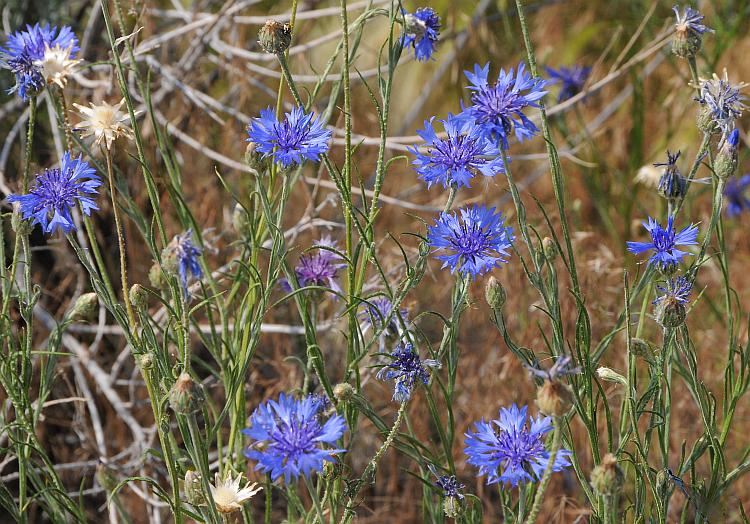Centaurea cyanus L.
Cornflower

Introduced
CC = *
CW = 3
MOC = 21
© SRTurner
Centaurea cyanus L.Cornflower | |
 |
Introduced CC = * CW = 3 MOC = 21 |
© SRTurner |
|
Family - Asteraceae/Cardueae Habit - Taprooted annual. Stems - Ascending to erect, to 1.2 m, with ascending branches above the midpoint, ridged, densely woolly when young.
Leaves - Alternate, 4-13 cm long; basal and lower stem leaves with the blades mostly 2-5 mm wide, linear or narrowly lanceolate, tapered to a sharply pointed tip, tapered gradually to a sessile or short-petiolate base, the margins entire or the basal leaves rarely with a few linear lobes; median and upper stem leaves somewhat reduced, mostly sessile, the base sometimes narrowly decurrent, the blades linear, entire. All leaves persistently woolly on undersurface. Inflorescence - Solitary terminal heads. Heads - Involucre 11-16 mm long, longer than wide, more or less bell-shaped. Lower and median involucral bracts with the body ovate, the margins entire, the outer surface glabrous or finely woolly, not concealed by the appendages; the apical appendage not strongly differentiated, ascending, the broad, white or brownish- to purplish-tinged margins papery and with coarse, ascending, triangular teeth. Upper involucral bracts similar but oblong-lanceolate.
Ray flowers - Absent, but marginal disk florets raylike. Disc flowers - Corollas of discoid florets 10-15 mm long, those of raylike florets 20-25 mm long, blue or less commonly purple, pink, or white. Marginal florets sterile; inner florets smaller, fertile. Pappus of numerous unequal bristles, these 2-4 mm long, straw-colored to brown, usually persistent at fruiting.
Fruits - Achenes 3.5-5.0 mm long, somewhat flattened, the attachment scar appearing lateral, the surface grayish brown to yellowish brown, brown or nearly black, with sometimes faint, lighter stripes, finely hairy. Flowering - May - September. Habitat - Prairies, waste ground, roadsides, railroads. Often cultivated. Origin - Native to Eurasia. Lookalikes - Potentially, other members of the Centaurea genus. Other info. - This plant is found in widely scattered locations throughout the state but is relatively uncommon except in cultivation. Its distribution across the continental U.S. is also widely scattered, though it is present in most counties near the west coast. The plant is relatively easy to recognize by general appearance, although plants with different colored flowers could be mistaken for other species. Photographs taken at Schumaker Park, 6-16-99 and 7-12-00, and by Tom's Creek, NC., 4-20-03 (DETenaglia); also on the north side of Upper Klamath Lake, Klamath County, OR, 7-16-2014 (SRTurner). |